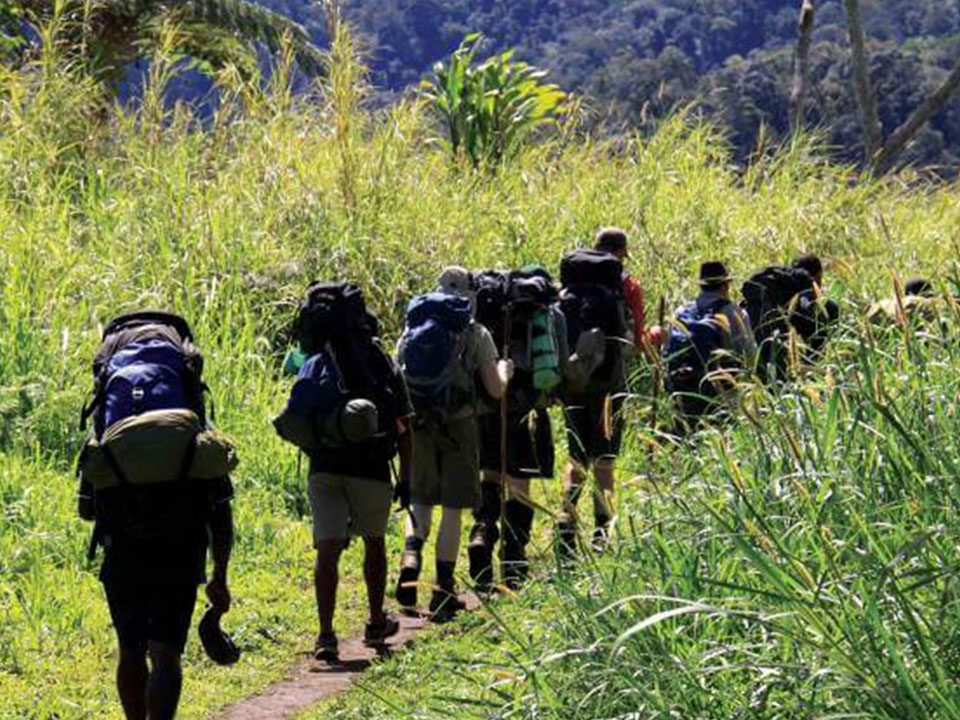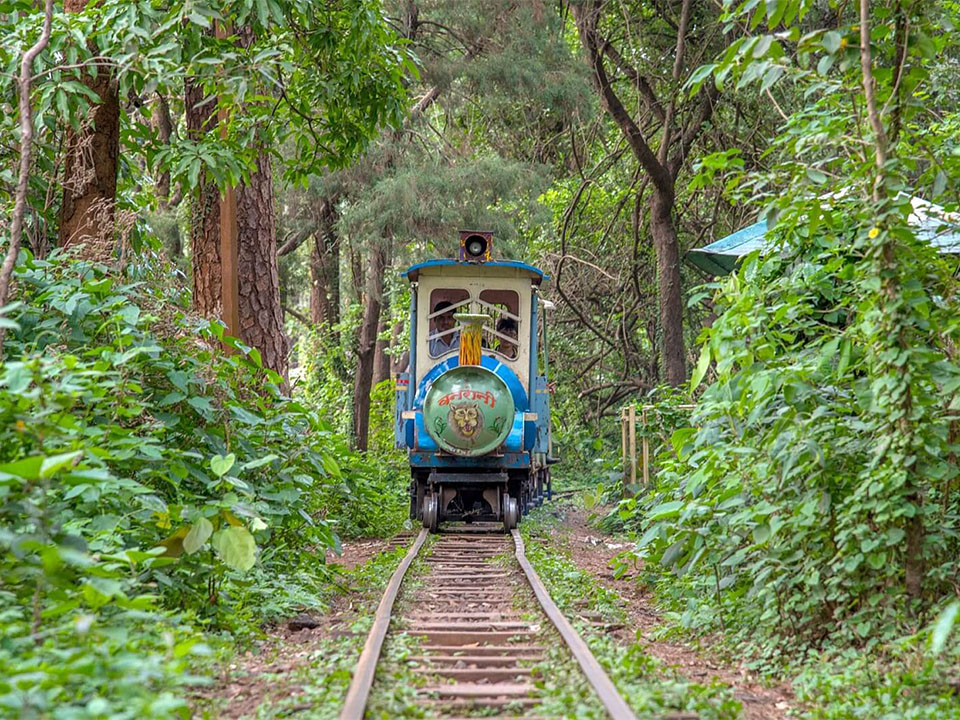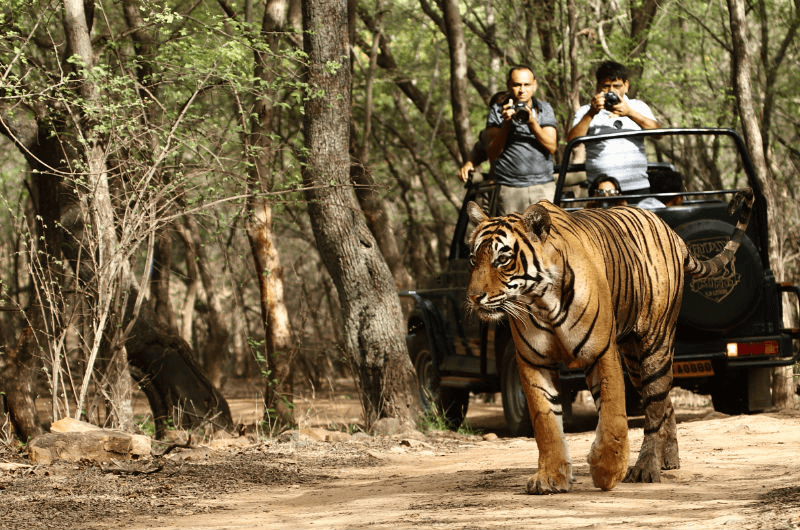The Dnyanganga Sanctuary is situated 28 km from Buldhana and 20 km from Khamgaon town of Maharashtra. It is in Buldhana District, near the Dnyanganga River. There are two lakes within the 205 sq km sanctuary. Leopards, sloth bears, barking deer, blue bulls, spotted deer, hyenas, jungle cats and jackals along with tigers give more attraction. About 150 species of birds are there. The ideal time to visit the sanctuary is from January to June. Wild animals are best sighted from February to May. The terrain is undulating, interspersed with hillocks having gentle slopes.
Managed by the Office of Field Director- Melghat Tiger Reserve, Maharashtra Forest Department, The Sanctuary is a natural habitat for various animals and bird species of which many were seasonal that came from different parts of the country.
Botha gate of Dnyanganga Wildlife Sanctuary is reachable by road from Khamgaon on the Khamgaon- Buldhana road.
Khamgaon is the nearest (20kms) railway station, on Nagpur-Mumbai main line.
The vegetation at Katepurna Sanctuary is southern tropical dry deciduous forest. There are over 115 species of plants at this sanctuary such as Behada, Dhawada, Moha, Tendu, Khair, Salai, Aola, Teude, etc.
Katepurna Wildlife Sanctuary is renowned for the four-horned antelope and barking deer. Other animals that you can see at the sanctuary include black buck, leopard, wolf, wild boar, hyena, hare, nilgai, jungle cat and monkey. Among the birds, Peafowl is the common bird spotted by tourists. You can also view several species of common grassland and wetland birds here. The Katepurna water reservoir attracts many water birds.
You can reach Katepurna Sanctuary comfortably by air, rail, and road. The closest airport is the Sonegaon Airport in Nagpur, located 292 km away. The Akola Junction Railway Station, situated 40 km away from Katepurna on the Mumbai-Nagpur rail route, is the closest railhead. Akola is well-connected by an extensive network of roads to all the major towns of Maharashtra.
The entry gate of Katepurna Wildlife Sanctuary is through Wagha gate which has 6 rooms and dormitories which can be booked online through the website www.magicalmelghat.com
The total area of the sanctuary is 18.321 sq.km. It is situated in right side of Karanja-Manora and left side of Karanja-Darva state highway. It is just 7 km from Karanja.
The main river of the sanctuary is Aadan. It derives its name from the Karanja & Sohal Village . It is a part of catchment area of the Aadan reservoir and it forms aquatic habitat for many floral and faunal species. The entire district has almost alluvial track drained by the Purna, Katepurna, Aadan and Painganga rivers. The sanctuary attracts large number of winter migratory birds between November and March.
The landscape is undulating and offer interesting contrast between the plateau and the plains. the tract is undulating, interspersed with open grasslands and wooded areas.
The landscape is undulating and offer interesting contrast between the plateau and the plains. the tract is undulating, interspersed with open grasslands and wooded areas.
The forest is “Southern Tropical Dry-deciduous Forests” in which Teak & Tendu is a predominant species.
17 mammalian species, 75 avian species, 18 reptilian species, 3 amphibian species and 23 fish species, 48 butterfly and spider species under faunal diversity.
Chital, Sambar, Neelgai, Black buck, wolf, Barking deer, Wild boar, Porcupine, Hyena, Jungle Cat etc are found in the Sanctuary.
An Island in the Aadan reservoir which hosts number of bird species.There are many water species found like Moorhen, Coots, Jackana, Ducks, Egrets, and crustaceans, insects, fishes, and frogs. About 75 avian species have been listed in which include 24 species of migratory birds and 51 species of resident birds
There are 20 tree species, 9 herb and shrub species, 4 climber species, 8 grass species under floral diversity.
The main species found in Sanctuary are khair, salai, hiwar, medshing, tendu etc.
Trees of neem, khair, salai, hiwar, medshing, tendu are found in the moist areas
It is also known as Lonar Crater, it is notified National Geo-heritage Monument. It is located at Lonar in Buldhana district, Maharashtra. Within the only known Extraterrestrial impact Crater found within the great deccan traps basaltic formation. It is recognized as an impact crater by the hypervelocity impact of either a comet or an asteroid. While Lonar lake is famous for being the largest basaltic impact crater. The Crater was formed 52000 year ago, when a blazing ball of fire crashed into the earth at an estimated speed of 90000 km per hour.
Lonar is named after the demon, Lonasura, and is ringed by fascinating temples, including one with erotic sculptures reminiscent of Khajuraho.
The Lonar Crater is the only crater in Basaltic rock formed by a meteorite impact in India ranking the 3rd biggest in the world.
United states Geographic Survey in America and the Geological Society of India, Physical Research Laboratory of India have done a lot of research on this lake.
Lonar ranks amongst the world’s five largest craters. Lonar Lake, which was created by a meteor hitting the Earth during the Pleistocene epoch, is a saltwater lake at Lonar in Buldana district. Lonar Lake has a mean diameter of 1.2 kilometers (3,900 ft) and is about 137 metres (449 ft) below the crater rim. The meteor crater rim is about 1.8 kilometers (5,900 ft) in diameter. The circular depression bears a saline water lake in its central portion.
Tipeshwar wildlife sanctuary is situated in Yavatmal area that is an isolated wildlife sanctuary in Maharashtra. This sanctuary is placed in Kelapur and Ghatanji tahasil of Yavatmal district that encloses an area of 148.63 sq.km. This sanctuary is widespread for its exotic hilly-undulating territory and wildlife miscellany. The Tipeshwar wildlife sanctuary found its name from the ‘Goddess Tipai’ that is sited near the Tipeshwar village in the sanctuary area.
It is also popularly known as Green Oasis located in Southern Maharashtra. The temperature of the area is very pleasant throughout the year. The tipeshwar wildlife sanctuary area is completely a basalt area that is constructed by the blast of lava a century back. This area is highly treasured for the diversity of wealthy Fauna such as Tiger, Leopard, Dhole, Hyena, Sambar, Jackal, Sloth bear, etc And flora such as herbs, grasses, bamboo forests.
The road (NH-44) goes to Tipeshwar Wildlife Sanctuary is through Pandharakwada. The district headquarters, Yavatmal which is also destined as Yavatmal, is at around 75 km's from the wildlife sanctuary at Tipeshwar.
Tipeshwar Sanctuary is around 35 km from Adilabad Railway station, the adjoining railway station in the proximate Telangana state. Amravati railway station and Badnera railway station are at about 165 kilometers distance from the wildlife sanctuary. Nagpur airport is around 172 km's distance from Tipeshwar wildlife forest. Mumbai is around 850 km's distance from Tipeshwar Wildlife Sanctuary.
The best time is to visit Tipeshwar forest is from October to June as there is heavy rainfall from June to September. The temperature in this sanctuary is quite pleasing all through the year
The Painganga Wildlife Sanctuary is a major Sanctuary area of Eastern Maharashtra which represents floral and faunal diversity of the biotic province 6B-Central Plateau of the Deccan Peninsula Zone. Fascinating geographic features, luscious landscapes and a vast range of activities- Painganga Wildlife Sanctuary is much more than a refuge for the animals. In this 400 sq.km land of a wildlife sanctuary, one can expect such rich, diverse flora and fauna that it would be hard to ignore revisiting here again and again. The wildlife sanctuary got its name from the facts that it is flanked by Painganga or Penganaga River on the three sides. Not only the landscapes but the vivacious variety of flora and fauna too also makes the tourist’s trip to Painganga Wildlife Sanctuary a little more interesting.
An exquisite mixture of southern mixed deciduous forests and dry teak forests shelters a good number of undomesticated animal species like Chinkara, the Black Buck, the Nilgai Sambar, the Four Horned Antelope, Hare, Jackal, Leopard, Fox and much more. Also, a pleasing number of birds can be heard chattering in the sanctuary like Vulture, Bulbul, Dove, Kingfisher, Cuckoo, and much more.
The best time is to visit Painganga forest is from October to June as there is heavy rainfall from June to September. The temperature in this sanctuary is quite pleasing all through the year.
By Airways: Shri Guru Gobind Singh Ji Airport in Nanded is the nearest airport, its 150 km away. Dr. Babasaheb Ambedkar International Airport in Nagpur is the nearest airport; it's 250 km away.
By Railways: Kinwat Railway Station is the nearest railway station, its 3 km away from Kharabi. (SCR)
By Roadways: Mumbai - Aurangabad - Jalna - Hingoli – Yeotmal – Painganga: 700 Km Buldhana – Akola – Yeotmal : 360 Km Yeotmal – Painganga : 100 Km These three are the three common routes that are used by the tourists to reach the Painganga Wildlife Sanctuary

Please follow the rules and regulation as per the wildlife protection act 1972 to avoid impose punishment for violating the same. The schedules give absolute protection to certain species and these cannot be infringed on any account.Offences related to trade and commerce in trophies, animals articles etc. Derived from certain animals attracts a term of imprisonment up to three years and/or a fine up to Rs. 25,000/-.

Melghat Tiger Reserve offers various activities like day safari, Full day Safari, Night Machaan Stay, Kayaking, Elephant ride, Trekking, Adventure activities like zorbi ball, Burma bridge, River crossing, Parallel bridge and many more. These various activities are available at tourist destination like Aamzari, Semadoh, Kolkas, Harisal, Shahanur. The tribal dance show can be arranged on request. Home stay facility is also provided to experience the culture & day to day life style of tribal.

Melghat tiger reserve has many places to explore. The popular destination for the tourism point of view are Chikhaldara, Aamzari, Semadoh, Kolkas, Harisal & Shahanur. Please find the details in 'How to reach" to these various destination in Melghat Tiger Reserve

Melghat keeps organizing various event for all. The list of popular events -Be a Naturalist, Mel-Con, Ephil Dodo, Bird Race, Monsoon Trek, Logo banao Logo, Photography competitions etc. To get updates about these events please follow our page Melghat Tiger Reserve on facebook.